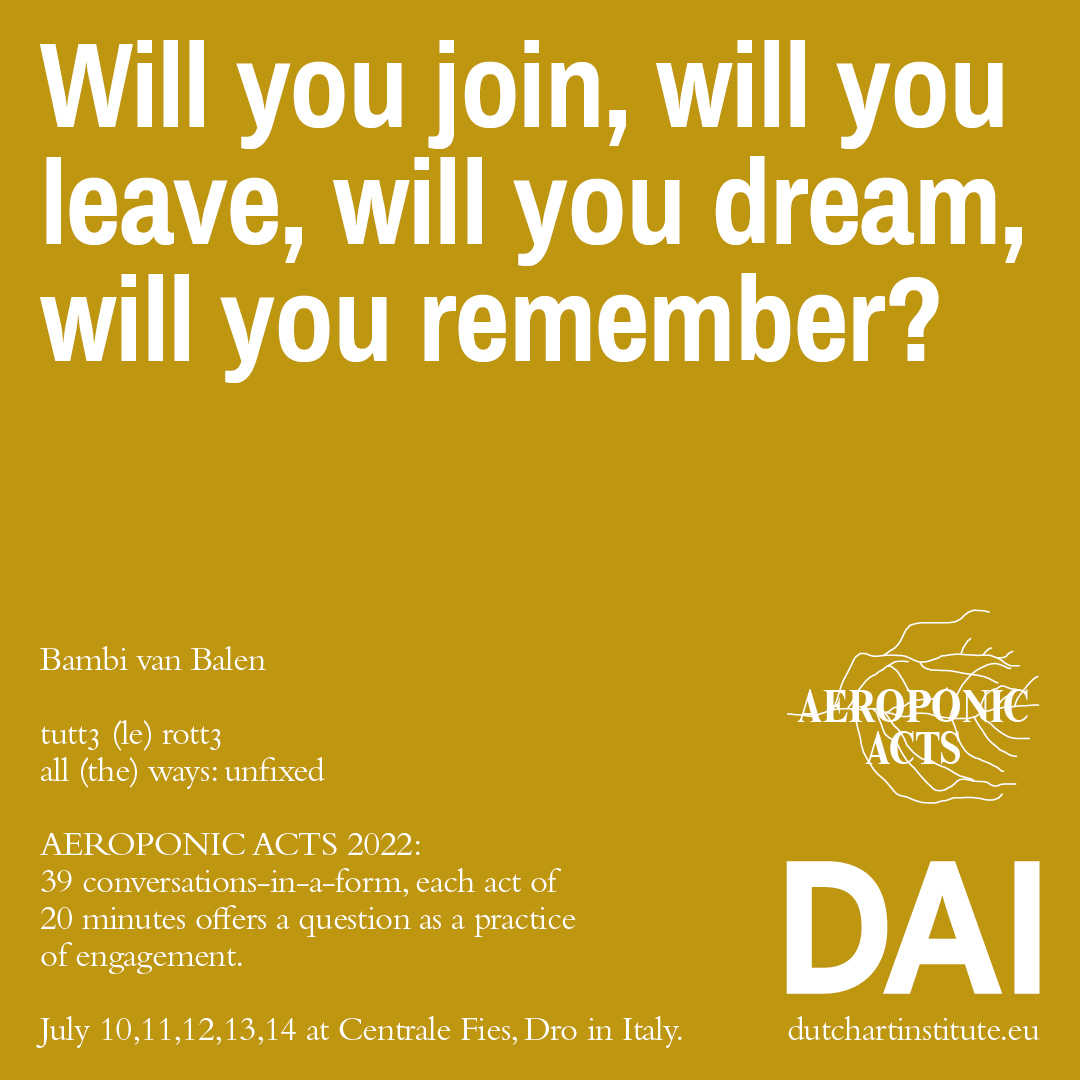Bambi van Balen: Cycles.
‘Aeroponic’ – root systems nourished by air – Acts is the name given to the nomadic Dutch Art Institute’s final Kitchen presentations. Each participant addresses one question, as a practice of engagement.
Here you will find the documentation of Bambi van Balen's presentation as filmed by Baha Görkem Yalım. The written report is by Hubert Gromny and it includes a summary of the comments by esteemed guest respondents.
Cycles.
Bambi's question: Will you join, will you leave, will you dream, will you remember?
Bambi's introduction: Feel free
to close your eyes,
to dance,
to lie down,
to play,
to put on a dress,
to switch the light,
to change the score.
-------------------
Warning:
In this presentation stroboscope lights will be used.
For people with photosensitive epilepsy, this might be triggering.
Instructions to switch the light:
1) Log in to WIFI network: RÆV
2) Type the following IP address on your browser: 192.168.1.202
3) Click the buttons to control the lights.
—------------------
A view in the kitchen of Bambi van Balen
Choreographic assistance: Elisa Giuliano
Performers: Bambi van Balen, Dandelion Eghosa, Max*ine Vajt
Dress: Guusje de Bruin, Sarah Kerbosch in collaboration with Bambi van Balen
Light programming: Jasper van Loenen
Music: aemlx (Emilia Kurylowicz), The Field, tbc*
Technics: Lau ten Zeldam, Peter Sattler, more tbc*
Support: Iarliath Ni Fheorais, Till Langschied
With support of Tools for Action Foundation
Hubert's report: Audience enters the dark space and is encouraged to sit on the stage. Electronic music is coming out of the speakers. In the middle of the stage LED blue and red lights are flowing in lines spiralling around the arms and hands of Bambi. Bambi spreads their arms, which resemble wings and start spinning slowly and steadily while kneeling. The music becomes faster and more rhythmic while the performer ascends to standing position and continues spinning, accelerating the movement. The lights are changing colors for pink, yellow and green while music acquires new sonic layers. The program of the lights can be controlled through phones of the audience. The movement of the performer becomes more and more expansive while lights enter the stroboscopic mode. With the music becoming faster Bambi starts running around the stage, among the audience and other parts of the room, stamping heavily on the floor, stairs and benches. The performance unfolds itself with growing intensity of sound, lights and movement of Bambi. Audience reacts loudly at moments of peaking intensity. After that performer comes back to the middle of the stage and spinning holding their arms up. They are slowing down and continue spinning until the music stops marking the end of the presentation.
Momtaza Mehri pointed out the intensity of the performance—in terms of the soundtrack, movement and figures created by the lightened hands. She observed a tension and effective creation of energy in the space by a choice of forcible soundtrack and terrifying moment of running in full speed around the audience. Momtaza noted that it was a provocative choice as it added another layer to the performance by allowing the audience to feel the vibrations through the floor, absorbing the sound with their bodies. As such, the audience was activated. The questions, which could be posed to the presentation include the consideration of how the audience is involved in the process of animation, what is being animated and how. Momtaza picking up on the history of transhumanist imagery added that it is important to have in mind that it is rooted in a long tradition and can be traced to earliest cultures, especially the one of ancient Egypt. Oftentimes this imagery is appropriated and emptied from its depth and immemorial meaning which is visible in space of Western quotidian culture (example of coffeeshops in Netherlands).
Phanuel Antwi appreciated the warning about stroboscope lights, which gave an audience an option not to participate. At the same time Phanuel found the piece to be challenging in terms of accessibility, as the warning was giving only two options: to stay or to leave. He observed that it is important to look at the consequences of artistic decisions and move beyond the desire to create a particular type of an artwork and instead to consider the audience attending the performance and the context this audience arrives at the presentation. Phanuel pointed out that in the cultures of rave and queer culture, which performance was evoking, the special attention to create a space of care is needed.
Ana Teixeira Pinto made a connection between LED lights, which transformed arms into a kind of technological wings to the transhumanist imagery. Ana referred to the 1910 novel ‘Mafarka: The Futurist’ by Filippo Tommaso Marinetti to speak about the presence of a metaphor of flight within futurist figurative language. Using this example Ana commented on potential danger of intersecting queer and transhumanist imageries, which needs careful observation.
Bambi van Balen's "Cycles." was presented before live audience at the Centrale Fies, Dro, Italy on July 12th.
Find the overview of all 24 AEROPONIC ACTS 2022 here: tuttə (le) rottə - all (the) ways: unfixed


